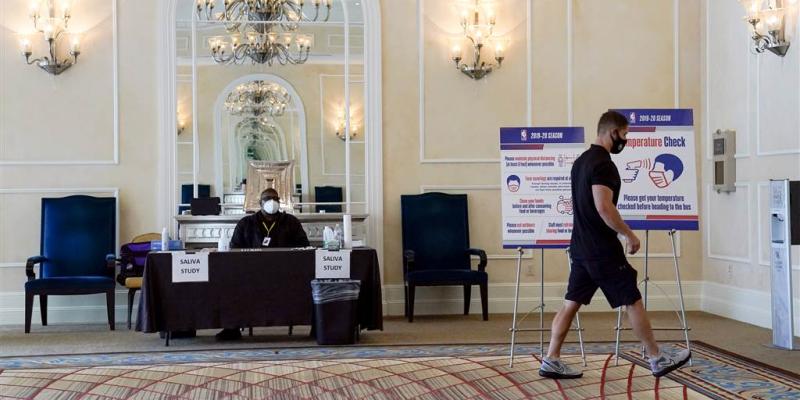How much will the SalivaDirect test help the U.S. testing crisis?



A newly authorized saliva-based coronavirus test is a step in the right direction, but it won't do much to ease the strain on labs as they process test results, experts say.
The Food and Drug Administration on Saturday issued an emergency use authorization, or EUA, for SalivaDirect, which can detect whether a person is infected with the coronavirus using saliva, rather than a sample taken from deep in the nasal cavity.
The test was developed by researchers at Yale University in partnership with the NBA, which had a need for frequent testing to restart its season safely and worked with the researchers to help validate the test.

FDA approves coronavirus saliva test for emergency use
SalivaDirect has several advantages over other diagnostic tests for the coronavirus, experts said, although it won't entirely solve the country's testing problems.
Saliva can be collected in any sterile container, and it's less invasive and simpler than the nasopharyngeal swabs that are commonly used now, said Dr. Charles Chiu, associate director of the University of California, San Francisco's Clinical Microbiology Laboratory.
Dr. Stanley Perlman, a professor of microbiology and immunology at the University of Iowa, said, "This will help with sample collection, making it easier and potentially safer."
Collecting a nasopharyngeal swab can put health care workers at risk, because it can expose them to the virus. A saliva sample, on the other hand, can be self-collected by the patient while health care workers supervise from a safe distance.
Let our news meet your inbox. The news and stories that matters, delivered weekday mornings. Sign Up
Once collected, samples can be pooled, allowing labs to test multiple peoples' samples at once. If the pooled sample comes back negative, all the samples in it are negative. If it comes back positive, the lab must go back and retest each sample individually.
Another advantage is that the test doesn't require any proprietary equipment or reagents to run. Other tests, for example, may need a special machine, or authorization is given to a specific lab.
Instead, SalivaDirect is simply a set of instructions. Once a lab can show that it is able to carry out the protocol, it can be authorized to do so by SalivaDirect.
Anne Wyllie, an epidemiologist at Yale who is one of the lead developers of the test, said her team has already been inundated with requests from labs looking to become authorized. She has also seen interest from local communities wondering whether they can get the test, as well.
"A number of emails that we were receiving are actually just from local community groups, whether it's primary schools, colleges, universities, who are hoping they can get this," Wyllie said, adding that she expects the test to become widely available to consumers in four to eight weeks. Wyllie and her team won't be profiting from the protocol.
SalivaDirect uses the same method to run the samples as many other COVID-19 tests — called polymerase chain reaction, or PCR — but notably, the test eliminates one of the steps from that procedure, and it can therefore be run in about half the time as traditional PCR, Wyllie said.
Skipping one of the steps sets the SalivaDirect test apart from the five other saliva tests that have been granted EUAs. And bypassing the step, which entails extracting the virus's genetic material from the sample, means the test isn't vulnerable to shortages required for that step, Chiu said.
Wyllie said she was hopeful that the test would have an impact on backlogs that labs are facing nationwide, but she said it was too early to tell.
Chiu, who wasn't involved with the development of the test, was less optimistic.
"I don't think that this is likely to greatly impact our testing bottleneck until a true point-of-care or at-home version of this test is available," he wrote in an email.
He said some concerns he has with the test are slow turnaround time for collection, transport to a laboratory and the PCR testing itself, which generally takes at least three hours.
Perlman, who also wasn't involved with SalivaDirect, agreed.
While this advancement in technology will help with getting the sample itself, it's still subject to many of the issues of PCR testing, he said.
As a result, Perlman said, "it will not help with any backlogs that result from steps after sample collection."
Even Wyllie said the SalivaDirect test isn't the end goal for COVID-19 testing. The ultimate goal, she said, is a rapid test that can be performed at home. She said she hopes that the authorization of her test using unconventional extraction methods is a sign that the FDA will now consider different testing methods, such as rapid at-home tests that aren't as sensitive as PCR, which is considered the gold standard.
"What we're seeing right now is a need to shift from that traditional idea of true diagnostic testing to a test that we can use for screening and surveillance," Wyllie said.
Akshay Syal is a medical fellow with the NBC News Health and Medical Unit.



I'm not good with spitting. It grosses me out especially when I have to do it
This could be important. One of the essential elements for getting control of the coronavirus is massive testing. Our Glorious Leader doesn't want lots of testing... but we can hope his fuçkups will soon cease. Then a test that's more rapid will be important.
The role of the NBA isn't specified, but we know that massive testing has been a key to the Association's highly successful "Covid-19-free" bubble in Orlando. If they've been using this test, that's pretty convincing.
There’s no national testing strategy for coronavirus. These states banded together to make one.
Since this article was written the group is now up to ten states and I believe that they are attempting to procure this type of test.
How insane is that?